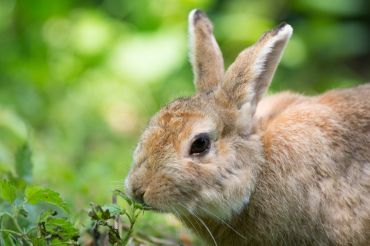
If you have rabbits in your garden, you know how it feels to look out in the morning and see a collection of bare nibbled stems where your plants used to be instead of beds filled with beautiful plants. Rabbits can be a menace in gardens, eating a wide variety of garden plants. While there’s no such thing as a completely rabbit-proof plant, there are some that seem less attractive to most rabbits. Here’s a list of some of the more successful rabbit-proof plants.
Top 10 Rabbit-Proof Plants
-
Helleborus x hybridus (Hellebore): These useful perennials will grow in the shade, have attractive palmate evergreen leaves, and flower in winter, adding colour to the garden. Not only rabbits, but also slugs and snails find their tough leaves unappetizing.
-
Euphorbia characias subsp. wulfenii (Mediterranean spurge): An evergreen perennial with grey-green leaves and vivid acid-green flowers in spring. When cut, the stems ooze a milky white sap that will irritate the skin, so wear gloves when working with euphorbias and take care not to get the sap in your eyes.
-
Digitalis (foxglove): A well-known and popular wildflower with tall flower spires in late spring and early summer. Foxgloves are biennial, producing leaves in their first year and flowers in their second, then setting seed and dying. They grow well in the shade and will self-seed and spread slowly around the garden if the conditions are right.
-
Alliums (ornamental onions): These easy-to-grow bulbs are a superb addition to a sunny border and range in size from compact chives (Allium schoenoprasum) to tall Allium giganteum with its enormous globe-like purple flower heads in summer.
-
Agapanthus (African lily): Rounded blue or violet flower heads on tall stems above clumps of long strappy leaves. These natives of Southern Africa look lovely in a sunny border.
-
Acanthus (bear’s breeches): With their big leaves and tall, upright purple and white flower stems, Acanthus make a bold statement in a large border. They are happy in the shade, but do tend to self-seed and spread.
-
Tagetes patula (French marigolds): With their cheerful orange or yellow flowers, these marigolds brighten up pots and window boxes, and they’re also good companion plants in vegetable gardens, attracting pollinators and deterring aphids.
-
Salvia x superba (hybrid sage): A classic border perennial with soft grey-green leaves and spires of purple flowers in late summer.
-
Bergenia (elephant’s ears): A low-growing perennial with large, tough, rounded leaves. It grows well in partial shade and flowers in early spring.
-
Eryngium (sea holly): A striking perennial with steel blue foliage and spiky-looking flowers that are magnets for bees in summer. It does best in well-drained soil in full sun.
We have a fantastic range of plants for all situations in our centres, so whatever you’re looking for, you’ll find something to suit your garden. Visit us today!




